Good morning, having been a relatively quiet start to the new year volatility returned to the markets with a vengeance last week as small traders took on the wall street monoliths in the stock market.
As the equity markets gyrated so did investor’s risk assessments and the dollar’s attraction waxed and waned. Regardless of whether it is American stock markets causing the change in sentiment, the dollar reacts almost simultaneously. As Asian bourses (stock exchange) open stronger this morning so do the beta currencies, such as sterling which has opened at $1.3725 against the dollar. World geopolitical tensions are also rising with Taiwan being threatened by China and new restrictions in Hong Kong. Europe’s attitude towards vaccines in administering them and the distribution is another worry for the market, and the euro looks set to suffer some more.
A busy and jumpy week is in prospect with initially the same data narratives looking likely to dominate trader’s thoughts. The pandemic’s containment and vaccine distribution will still be uppermost in determining the direction of currencies, and the pound seems the most likely to benefit. Any further delay in distributing vaccines will add to the markets’ generally gloomy mood as their success is linked directly to economic recovery. We have a data-heavy week ahead in both Europe and the US. We will be watching to see if European data continues to be generally downbeat this week, unlike the US, which was mostly upbeat with GDP beating expectations last week. The markets will also be watching for hints from the Bank of England on policy and to see if any progress can be made on the US’s fiscal stimulus bill. And of course, whether the retail trader phenomenon continues and the authorities’ responses to it.
UK
Last week, the pound put in a good performance holding up well against the resurgent dollar and gaining against the euro. Slightly better than expected employment data gave the pound a boost as did the vaccination programme’s continuing success, which has seen over 12% of the population inoculated. Sterling is also benefitting from what appears to be, at least in the short term, a relatively painless departure from the EU. It has opened at €1.1320 against the euro as the market awaits to see how Wall Street moves this afternoon. The critical event we will be watching out for this week is the monthly Bank of England meeting on Thursday. No change is expected on its monetary policy, but its review of negative interest rates will be watched for any hints that they could be enacted. The BoE Governor is also set to speak on Friday afternoon. Away from the Old Lady, a quiet week on the data docket is in prospect apart from the Markit Manufacturing Purchasing Managers Index which is released this morning.
Euro
The political backdrop in Europe looks likely to continue to worry the markets as disquiet is increasingly being manifested at both lockdowns and the slow rate of vaccinations, culminating in the spat between the commission and the drug manufacturers. Investors now fear that these feelings will manifest themselves at the ballot box when countries including the Netherlands, Germany, and France, have upcoming elections causing upheaval in the current political establishment. A hectic week ahead for data in the Eurozone with Gross Domestic Product for the fourth quarter released tomorrow. Individual country estimates indicate that the second wave hasn’t impacted as negatively as the first. Later this morning the latest unemployment figure for the eurozone are released. On Wednesday, January’s inflation reading is released where an uptick is expected and Thursday the latest Retail Sales.
US
Another challenging week looks to be in prospect for Joe Biden. Global stock markets are possibly set to move wildly again as day traders in the US battle with hedge funds. As this happens, risk sentiment will swing around taking the dollar with it, and beta currencies such as sterling will follow. Several speakers from the Fed are scheduled this week, and investors will be listening for any response they show to the markets’ extraordinary conditions. The new administration is still trying to drive its $1.9tn stimulus plan into law, and it now looks like Joe Biden will be forced to split the package into separate bills. Also clouding the water is the impeachment trial of Donald Trump on 8th February. The eyes and ears of the financial markets will turn to the States in the early afternoon on Friday when January’s employment, Nonfarm Payroll, data is released on Friday. These will be preceded as usual by the ADP white-collar employment data on Wednesday and the weekly jobless claims on Thursday.
Scandi
January proved to be relatively uneventful and the Swedish krona was rangebound throughout most of it. This, despite rumours in the financial press that the schedule for repayment of foreign exchange loans announced by the Riksbank as the krona was strengthening, was done to manipulate it lower. February kicks off this morning with the Swedbank Manufacturing PMI, and we will also get a flash GDP reading. Later in the week, we will get a reality check on the Swedish housing market on Tuesday and on Friday the Budget Balance is published.
The Norwegian krone ended the month on average lower against most G10 currencies even though Norges Bank Governor Olsen once again warned the market that a rate hike may come much sooner than anticipated. This week starts with the DNB PMI Manufacturing Survey followed on Friday by the Industrial Production figure.
In Denmark Sunday was spent celebrating the 26 – 24 wins against Sweden in the final of the World Men’s Handball Championships. Welcome news for a nation battling an impeachment case and still reeling from the decision that killed Europe’s largest fur export industry in less than a week. We will monitor any decisions concerning the compensation due to the mink farmers and any further political drama that may unfold due to the aforementioned.

